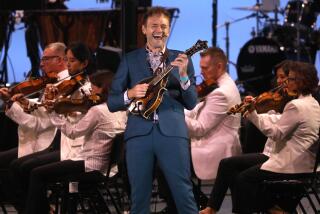Accordion’s range put on display
- Share via
Describing the music of Norwegian accordionist Frode Haltli in a few words is like trying to do a miniaturist painting of one of his country’s magnificent fiords.
The quartet he brought to the Harold M. Williams Auditorium at the Getty Center on Friday night may have seemed like a modest chamber group ensemble: Haltli playing accordion, Darryl Harper on clarinet, Nils Okland on violin and Hardanger fiddle, and vocalist-composer Maja Solveig Kjelstrup Ratkje. But the selections they played, all chosen from Haltli’s contemporary look at traditional Norwegian music on his new ECM recording, “Passing Images,” reached into remarkably diverse directions.
Beginning with the appropriately titled, pensively atmospheric “Psalm,” the quartet immediately established an ambience of shifting dynamic contrasts, passages of surprisingly complex harmonic textures contrasting with hypnotic repetitions and moments of pin-drop silence.
Traditional Scandinavian songs such as “Jag haver ingen karare” and “Lyrisk Vals” (“Lyrical Waltz”), Haltli’s adaptation of an early 20th century work by violinist Gustav Katerud, simmered with cross-cultural echoes -- an occasional trace of Roma melody, fragments of Celtic buoyancy.
The most unusual number -- “Passing Images” Ratkje’s strikingly contemporary, John Cage-inspired reinvention of “Lyrisk Vals” -- employed techniques of 1960s avant-garde happenings while remaining in touch with the sweetness of the original material.
Ratkje’s singing added ethereal touches to the music, with her high squeaks, low moans and occasional beat-box sounds.
Understandably, Haltli’s accordion playing was the engine and the heartbeat of the group’s performance. He is a masterful player of the complex, technically demanding European button accordion, from which he effortlessly coaxed an impressive array of sounds and techniques embracing bent notes, percussive accents, puffs of bellows-driven air sounds, moving contrapuntal lines and tonal textures.
In his hands, the accordion -- too-often maligned despite its presence reaching from French musette and cabaret music to Cajun, polka, Mexican norteno and Brazilian forro -- was irresistibly alive, as ethereal yet palpably real as a warm breath floating in Arctic air.
More to Read
The biggest entertainment stories
Get our big stories about Hollywood, film, television, music, arts, culture and more right in your inbox as soon as they publish.
You may occasionally receive promotional content from the Los Angeles Times.










